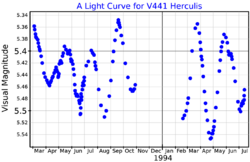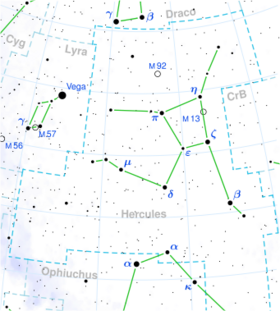Astronomy:89 Herculis
| Observation data Equinox J2000.0]] (ICRS) | |
|---|---|
| Constellation | Hercules |
| Right ascension | 17h 55m 25.18845s[1] |
| Declination | 26° 02′ 59.9701″[1] |
| Apparent magnitude (V) | (5.34 - 5.54[2]) |
| Characteristics | |
| Evolutionary stage | post-AGB |
| Spectral type | F2Ibe[3] |
| U−B color index | −0.34[4] |
| B−V color index | +0.34[4] |
| Variable type | SRd[2] |
| Astrometry | |
| Radial velocity (Rv) | −28.5[5] km/s |
| Proper motion (μ) | RA: 3.894[1] mas/yr Dec.: 5.193[1] mas/yr |
| Parallax (π) | 0.6893 ± 0.0718[1] mas |
| Distance | approx. 4,700 ly (approx. 1,500 pc) |
| Absolute magnitude (MV) | −6.5[6] |
| Details | |
| 89 Her A | |
| Mass | 1.0[7] M☉ |
| Radius | 71.0[7] R☉ |
| Luminosity | 8,350[7] L☉ |
| Surface gravity (log g) | 0.55[3] cgs |
| Temperature | 6,550[3] K |
| Metallicity | −0.5[3] |
| Rotational velocity (v sin i) | 23[8] km/s |
| Other designations | |
| Database references | |
| SIMBAD | data |
| Exoplanet Archive | data |
89 Herculis is a binary star system located about 4,700 light years away from the Sun in the northern constellation of Hercules. It is visible to the naked eye as a faint, fifth magnitude star. The system is moving closer to the Earth with a heliocentric radial velocity of −28.5 km/s.[5]
This is a spectroscopic binary with the pair surrounded by a dusty disc, and an hourglass-shaped nebula formed from outflowing gas.[10] The mass of the nebula is about 0.018 M☉, of which a majority is in the outflow.[10] The system shows variable brightness and spectral line profiles.[11] The companion has a very low mass and luminosity and orbits the primary in 288 days.[3]

The primary component has a stellar classification of F2Ibe,[3] and is among a rare class of post-asymptotic giant branch stars – low-mass stars in the last stages of their lives, highly inflated to appear as supergiants.[3] It is classified as a semiregular variable star, subtype SRd, and ranges from magnitude 5.3 down to 5.5 over a period of around 68 days.[2] The star has expanded to 71[7] times the Sun's radius and is radiating 8,350[7] times the Sun's luminosity from its enlarged photosphere at an effective temperature of 6,550 K.[3]
References
- ↑ 1.0 1.1 1.2 1.3 1.4 Brown, A. G. A. (August 2018). "Gaia Data Release 2: Summary of the contents and survey properties". Astronomy & Astrophysics 616: A1. doi:10.1051/0004-6361/201833051. Bibcode: 2018A&A...616A...1G. Gaia DR2 record for this source at VizieR.
- ↑ 2.0 2.1 2.2 Samus, N. N. et al. (2009). "VizieR Online Data Catalog: General Catalogue of Variable Stars (Samus+ 2007-2013)". VizieR On-line Data Catalog: B/GCVS. Originally Published in: 2009yCat....102025S 1. Bibcode: 2009yCat....102025S.
- ↑ 3.0 3.1 3.2 3.3 3.4 3.5 3.6 3.7 Hillen, M.; Verhoelst, T.; Van Winckel, H.; Chesneau, O.; Hummel, C. A.; Monnier, J. D.; Farrington, C.; Tycner, C. et al. (2013). "An interferometric study of the post-AGB binary 89 Herculis. I. Spatially resolving the continuum circumstellar environment at optical and near-IR wavelengths with the VLTI, NPOI, IOTA, PTI, and the CHARA Array". Astronomy & Astrophysics 559: A111. doi:10.1051/0004-6361/201321616. Bibcode: 2013A&A...559A.111H.
- ↑ 4.0 4.1 Ducati, J. R. (2002). "VizieR Online Data Catalog: Catalogue of Stellar Photometry in Johnson's 11-color system". CDS/ADC Collection of Electronic Catalogues 2237. Bibcode: 2002yCat.2237....0D.
- ↑ 5.0 5.1 Wilson, Ralph Elmer (1953). "General catalogue of stellar radial velocities". Washington. Bibcode: 1953GCRV..C......0W.
- ↑ Kipper, Tõnu (2011). "On the Optical Spectrum of 89 Her". Baltic Astronomy 20: 65. doi:10.1515/astro-2017-0269. Bibcode: 2011BaltA..20...65K.
- ↑ 7.0 7.1 7.2 7.3 7.4 Hillen, M.; Menu, J.; Van Winckel, H.; Min, M.; Gielen, C.; Wevers, T.; Mulders, G. D.; Regibo, S. et al. (2014). "An interferometric study of the post-AGB binary 89 Herculis. II. Radiative transfer models of the circumbinary disk". Astronomy & Astrophysics 568: A12. doi:10.1051/0004-6361/201423749. Bibcode: 2014A&A...568A..12H.
- ↑ Hoffleit, Dorrit; Jaschek, Carlos (1991). "The Bright star catalogue". New Haven. Bibcode: 1991bsc..book.....H.
- ↑ "89 Her". SIMBAD. Centre de données astronomiques de Strasbourg. http://simbad.u-strasbg.fr/simbad/sim-basic?Ident=89+Her.
- ↑ 10.0 10.1 Gallardo Cava, I.; Alcolea, J.; Bujarrabal, V.; Gómez-Garrido, M.; Castro-Carrizo, A. (2023). "The nebula around the binary post-AGB star 89 Herculis". Astronomy & Astrophysics 671: A80. doi:10.1051/0004-6361/202244415. Bibcode: 2023A&A...671A..80G.
- ↑ Burki, G.; Mayor, M.; Rufener, F. (1980). "Study of the Variable F-Type Supergiants HD161796 and HD163506 in Radial Velocity and Photometry". Astronomy and Astrophysics Supplement 42: 383. Bibcode: 1980A&AS...42..383B.
- ↑ Fernie, J. D.; Seager, S. (September 1995). "V441 Herculis (89 Her) and V814 Herculis (HD 161796) in 1993 and 1994". Publications of the Astronomical Society of the Pacific 107: 853–855. doi:10.1086/133632. Bibcode: 1995PASP..107..853F. https://ui.adsabs.harvard.edu/abs/1995PASP..107..853F. Retrieved 10 January 2022.
External links
- Kaler's, James B.. "89 Herculis". Stars. University of Illinois. http://stars.astro.illinois.edu/sow/89her.html.
 |


